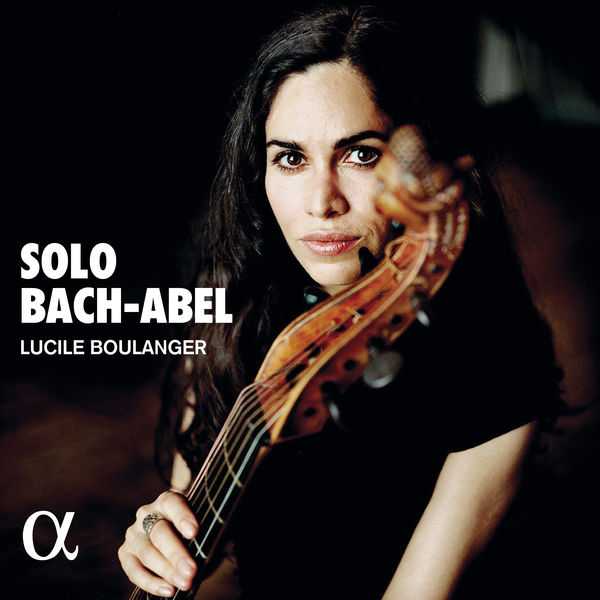

Composer: Carl Friedrich Abel, Johann Sebastian Bach
Performer: Lucile Boulanger
Number of Discs: 2
Format: FLAC (tracks)
Label: Alpha
Catalogue: ALPHA783
Release: 2022
Size: 3 GB
Recovery: +3%
Scan: yes
CD 01
01. Bach: Prelude and Fugue in C Major, BWV 846: Prelude
02. Bach: Cello Suite No. 6 in D Major, BWV 1012: Allemande
03. Bach: Cello Suite No. 3 in C Major, BWV 1009: Courante
04. Bach: Cello Suite No. 6 in D Major, BWV 1012: Sarabande
05. Bach: Cello Suite No. 6 in D Major, BWV 1012: Gavottes
06. Bach: Gigue (After Abel’s Allegro in A Major, WK 212)
07. Abel: Adagio in D Minor, WK 209
08. Abel: [Andante] in D Minor, WK 206
09. Abel: Allegro in D Minor, WK 207
10. Bach: Prelude in C Minor for Lute, BWV 999
11. Bach: Bourée Angloise for the Flute, BWV 1013
CD 02
01. Abel: [Arpeggio] in D Minor, WK 205
02. Abel: [Moderato] in D Minor, WK 208
03. Abel: Allegro in D Major, WK 186
04. Abel: Fugue in D Major, WK 196
05. Abel: [Adagio] in D Major, WK 187
06. Abel: Minuet in D Major, WK 200
07. Abel: Vivace in D Major, WK 190
08. Bach: Grave for the Keyboard or Violin, BWV 964/1003
09. Bach: Fuga for the Lute or Violin, BWV 1000/1001
10. Bach: Siciliana for the Violin, BWV 1001
11. Bach: Allegro for the Violin, BWV 1003
This is Lucile Boulanger’s first solo recital. The French gambist, universally praised for her natural and moving playing – BBC Music Magazine even described her as ‘the Jacqueline du Pré of the viola da gamba’ – juxtaposes Bach with Carl Friedrich Abel, a great master of the bass viol and a close friend of the Bach family. Although Johann Sebastian never wrote for solo viola da gamba, we know that he transcribed many of his works for other instruments. So Lucile Boulanger has chosen, for example, to transcribe three dances from the Sixth Suite, ‘because it sounds particularly good on the viol, being written for five-stringed cello (a step towards the six or seven strings of the viol?). It is in D, the viol key par excellence, and its style, already somewhat galant, is reminiscent of Abel. . . . This album gives me the opportunity to showcase the viol as both a melodic instrument – with the grain of the bow, the fragility of tone – and a polyphonic one.’
Familiar music heard through an unfamiliar prism. It was par for the course in the Baroque era, when transcription and pasticcio (patching together multifarious pieces by different composers to create a new work) were part of every musician and composer’s everyday musical toolkit. These days, though, not so much, meaning that when an artist does get as creative with 18th century repertoire as gambist Lucile Boulanger has been on this first solo recording of hers for Alpha, it’s all the more of a pleasure.
Those who know their viola da gamba repertoire will be unsurprised at the presence of pre-classical-era composer Carl Friedrich Abel on this solo programme, given his renown both in his day and now as one of the gamba greats. To pair him with J. S. Bach, though, is entirely unexpected, because while the king of Baroque did write three accompanied gamba sonatas, he never explored the instrument’s solo capabilities. Yet the two men were in fact linked both musically and personally. First, because Bach was Abel’s godfather, and probably also one of his musical instructors. Second, because of Abel’s friendship with Bach’s son Johann Christian, the tangible legacy of which was the Bach-Abel subscription concert series they founded together in 1760s London after Johann Christian followed Abel across the channel.
Boulanger’s aim therefore has been to make the link in a solo viola da gamba programme that existed between the two men in real life, juxtaposing original works for it from Abel’s famous Drexel manuscript, with her own new transcriptions of Bach works, presented as “pasticcio suites” reminiscent of the suites, sonatas and partitas Bach wrote for solo cello and violin. Cleverly, to give herself a head start as to how Bach himself may have gone about this transcription process, she’s selected pieces he worked his own transcriptions from – works such as the famous Prelude in C major BWV 846/846a, and the A minor Grave for keyboard or violin BWV 964/1003. Equally cleverly, she’s also looked closer to home by way of three dances from Bach’s final (6th) Solo Cello Suite in D major – because not only is D major a highly typical key for viola da gamba, but this particular suite was originally not for the standard four-stringed cello but instead a five-stringed one, bringing it closer to the viola da gamba with its five to seven strings.
The whole works wonderfully well. On the linguistic front, while Abel may have been a generation onwards of Bach, and with a trailblazing outlook that saw his symphonies influence Mozart, he adopted a more retro language for the viola da gamba. So, when Bach was an enthusiastic follower and imitator of the latest styles right up to his 1750 death, their respective works are effortlessly mutually complimentary here. Ultimately though, the joy of this album is Boulanger’s playing: the elegant legato flow and melancholically improvisatory feel to Abel’s Adagio in D minor, WK 209; the delicacy with which she articulates Bach’s aforementioned C major Prelude, and the array of shapes, light and shade she’s brought to its “arpeggio” figures; her rivetingly developed musical argument in Abel’s Vivace in D major, WK 190, fingers dancing with feather-like grace over its fast-figurations and embellishments, and double-stopped passages executed to perfection.